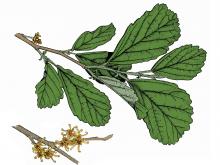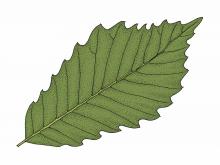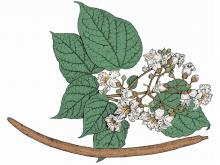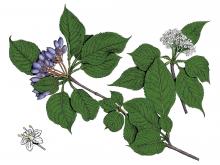Trees, Shrubs and Woody Vines
Media

Species Types
Scientific Name
Euonymus fortunei
Description
Introduced from Asia as a groundcover, wintercreeper has escaped cultivation in all the eastern states. It’s frequently found near urban centers, with heavy infestations in woodlands around St. Louis and Kansas City.
Media

Species Types
Scientific Name
Campsis radicans
Description
Each summer, the bright orange and red “trumpets” of this woody vine decorate Missouri’s cliff faces, telephone poles, and anything else strong enough to support it. Hummingbirds zoom to trumpet creeper’s flowers for their nectar.
Media

Species Types
Scientific Name
Hamamelis vernalis
Description
Ozark witch-hazel is a large native shrub that grows along dry, rocky streambeds in southern and east-central Missouri. The yellow, ribbonlike flowers bloom as early as January. In the fall, the seeds are ejected forcefully, to a distance of up to 30 feet!
Media

Species Types
Scientific Name
Quercus muehlenbergii
Description
Chinkapin oak is fairly easy to identify because of its distinctively toothed leaves. Look for it growing in rocky soils derived from limestone or dolomite on bluffs and in upland woods, and in floodplain forests and lower slopes along streams.
Media

Species Types
Scientific Name
Catalpa speciosa
Description
Of the three species of catalpas in our state, northern catalpa is the only one native to Missouri (specifically, the Bootheel region). It has been planted widely, though, and has naturalized in many places. A popular ornamental and shade tree with pretty, orchidlike flowers and long, beanlike fruit.
Media

Species Types
Scientific Name
Staphylea trifolia
Description
American bladdernut is a thicket-forming shrub or small tree that grows in moist soils. It produces clusters of bell-shaped white flowers in spring and unusual 3-parted air-filled capsules in late summer that turn papery and persist into winter.
Media

Species Types
Scientific Name
Viburnum lentago
Description
Nannyberry is an understory shrub or small tree that grows in low woods, wooded slopes, and rich valleys near streams. It is officially a Species of Conservation Concern in our state, but its rarity here may be because Missouri is at the southern end of its range.
Media

Species Types
Scientific Name
Quercus shumardii
Description
Shumard oak is worth knowing: it can rise to 100 feet in height and gain a trunk diameter of 5 feet, with wide-spreading, muscular boughs.
Media

Species Types
Scientific Name
Quercus palustris
Description
Pin oak is one of the easiest trees to recognize by its shape alone: It has a tall, straight trunk, an overall pyramidal or conical shape and, most notably, the branches on the lower third of the tree angle downward.
Media

Species Types
Scientific Name
Quercus texana
Description
In Missouri, Nuttall's oak grows naturally only in Bootheel. With its limited range, and with steady destruction of its habitat, it has become rare and imperiled within our borders.
See Also
About Trees, Shrubs and Woody Vines in Missouri
There are no sharp dividing lines between trees, shrubs, and woody vines, or even between woody and nonwoody plants. “Wood” is a type of tissue made of cellulose and lignin that many plants develop as they mature — whether they are “woody” or not. Trees are woody plants over 13 feet tall with a single trunk. Shrubs are less than 13 feet tall, with multiple stems. Vines require support or else sprawl over the ground.





















